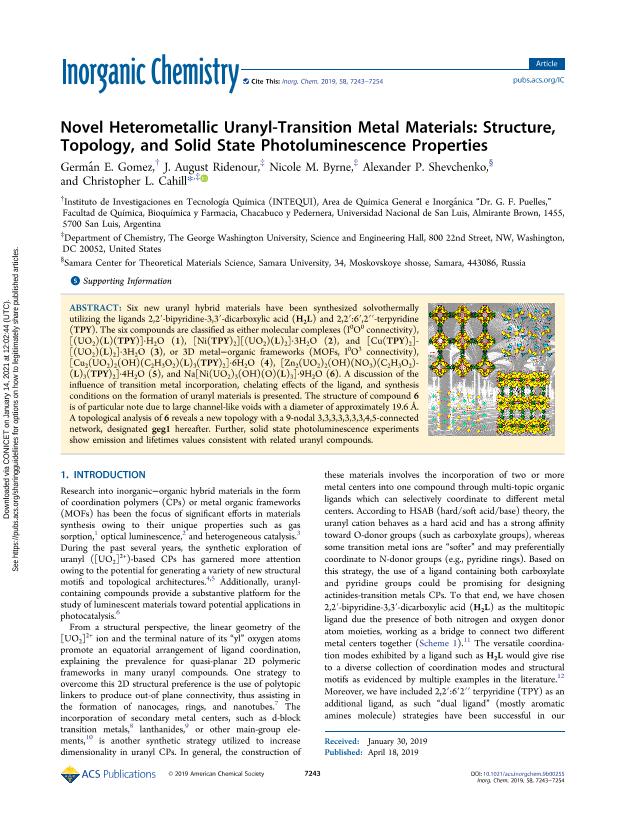Mostrar el registro sencillo del ítem
dc.contributor.author
Gomez, Germán Ernesto

dc.contributor.author
Ridenour, J. August
dc.contributor.author
Byrne, Nicole M.
dc.contributor.author
Shevchenko, Alexander P.
dc.contributor.author
Cahill, Christopher L.
dc.date.available
2021-01-18T20:05:20Z
dc.date.issued
2019-04-18
dc.identifier.citation
Gomez, Germán Ernesto; Ridenour, J. August; Byrne, Nicole M.; Shevchenko, Alexander P.; Cahill, Christopher L.; Novel heterometallic uranyl-transition metal materials: Structure, topology, and solid state photoluminescence properties; American Chemical Society; Inorganic Chemistry; 58; 11; 18-4-2019; 7243-7254
dc.identifier.issn
0020-1669
dc.identifier.uri
http://hdl.handle.net/11336/122926
dc.description.abstract
Six new uranyl hybrid materials have been synthesized solvothermally utilizing the ligands 2,2′-bipyridine-3,3′-dicarboxylic acid (H2L) and 2,2′:6′,2′′-terpyridine (TPY). The six compounds are classified as either molecular complexes (I0O0 connectivity), [(UO2)(L)(TPY)]·H2O (1), [Ni(TPY)2][(UO2)(L)2]·3H2O (2), and [Cu(TPY)2][(UO2)(L)2]·3H2O (3), or 3D metal–organic frameworks (MOFs, I0O3 connectivity), [Cu2(UO2)2(OH)(C2H3O2)(L)3(TPY)2]·6H2O (4), [Zn2(UO2)2(OH)(NO3)(C2H3O2)(L)3(TPY)2]·4H2O (5), and Na[Ni(UO2)3(OH)(O)(L)3]·9H2O (6). A discussion of the influence of transition metal incorporation, chelating effects of the ligand, and synthesis conditions on the formation of uranyl materials is presented. The structure of compound 6 is of particular note due to large channel-like voids with a diameter of approximately 19.6 Å. A topological analysis of 6 reveals a new topology with a 9-nodal 3,3,3,3,3,3,3,4,5-connected network, designated geg1 hereafter. Further, solid state photoluminescence experiments show emission and lifetimes values consistent with related uranyl compounds.
dc.format
application/pdf
dc.language.iso
eng
dc.publisher
American Chemical Society

dc.rights
info:eu-repo/semantics/openAccess
dc.rights.uri
https://creativecommons.org/licenses/by-nc-sa/2.5/ar/
dc.subject
MOFs
dc.subject
URANYL
dc.subject
LUMINISCENCE
dc.subject
STRUCTURE
dc.subject.classification
Química Inorgánica y Nuclear

dc.subject.classification
Ciencias Químicas

dc.subject.classification
CIENCIAS NATURALES Y EXACTAS

dc.title
Novel heterometallic uranyl-transition metal materials: Structure, topology, and solid state photoluminescence properties
dc.type
info:eu-repo/semantics/article
dc.type
info:ar-repo/semantics/artículo
dc.type
info:eu-repo/semantics/publishedVersion
dc.date.updated
2021-01-13T16:21:40Z
dc.journal.volume
58
dc.journal.number
11
dc.journal.pagination
7243-7254
dc.journal.pais
Estados Unidos

dc.description.fil
Fil: Gomez, Germán Ernesto. Consejo Nacional de Investigaciones Científicas y Técnicas. Centro Científico Tecnológico Conicet - San Luis. Instituto de Investigaciones en Tecnología Química. Universidad Nacional de San Luis. Facultad de Química, Bioquímica y Farmacia. Instituto de Investigaciones en Tecnología Química; Argentina
dc.description.fil
Fil: Ridenour, J. August. The George Washington University; Estados Unidos
dc.description.fil
Fil: Byrne, Nicole M.. The George Washington University; Estados Unidos
dc.description.fil
Fil: Shevchenko, Alexander P.. Samara University; Rusia
dc.description.fil
Fil: Cahill, Christopher L.. The George Washington University; Estados Unidos
dc.journal.title
Inorganic Chemistry

dc.relation.alternativeid
info:eu-repo/semantics/altIdentifier/url/https://pubs.acs.org/doi/10.1021/acs.inorgchem.9b00255
dc.relation.alternativeid
info:eu-repo/semantics/altIdentifier/doi/https://doi.org/10.1021/acs.inorgchem.9b00255
Archivos asociados
